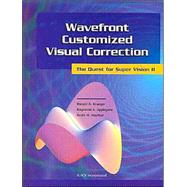
| Dedication | p. ii |
| Acknowledgments | p. vi |
| About the Editors | p. vii |
| Contributors | p. viii |
| Foreword | p. xii |
| Introduction | p. xiii |
| Preface | p. xiv |
| Introduction | |
| An Introduction to Wavefront-Guided Visual Correction | p. 3 |
| A Review of Basic Wavefront Optics | p. 9 |
| How Far Can We Extend the Limits of Human Vision? | p. 19 |
| Ophthalmic Wavefront Sensing: History and Methods | p. 39 |
| Retinal Imaging Using Adaptive Optics | p. 43 |
| Wavefront Diagnostics and Standards | |
| Basic Science Section | |
| Assessment of Optical Quality | p. 55 |
| Assessment of Visual Performance | p. 65 |
| Metrics to Predict the Subjective Impact of the Eye's Wave Aberration | p. 77 |
| Wavefront Information Sampling, Fitting, and Conversion to a Correction | p. 85 |
| Chromatic Aberration and Its Impact on Vision | p. 91 |
| Optical Quality of the Eye and Aging | p. 101 |
| Variation in Ocular Aberrations Over Seconds, Minutes, Hours, Days, Months, and Years | p. 109 |
| Accommodation Dynamics and Its Implication on Customized Corrections | p. 115 |
| The Implications of Pupil Size and Accommodation Dynamics on Customized Wavefront-Guided Refractive Surgery | p. 121 |
| Clinical Science Section: Commercially Available Wavefront Devices | |
| Shack-Hartmann Aberrometry: Historical Principles and Clinical Applications | p. 127 |
| Optimizing the Shack-Hartmann Wavefront Sensor | p. 131 |
| Retinal Imaging Aberrometry: Principles and Application of the Tscherning Aberrometer | p. 137 |
| Retinal Imaging Aberrometry: Principles and Applications of the Tracey (Ray Tracing) Aberrometer | p. 145 |
| Retinoscopic Double Pass Aberrometry: Principles and Application of the Nidek OPD-Scan | p. 149 |
| Spatially Resolved Refractometry: Principles and Application of the Emory Vision InterWave Aberrometer | p. 155 |
| Comparing Wavefront Devices | p. 161 |
| Wavefront Customized Corneal Ablation | |
| Basic Science Section | |
| Physics of Customized Corneal Ablation | p. 171 |
| Technology Requirements for Customized Corneal Ablation | p. 181 |
| Eye Tracking and Alignment in Refractive Surgery: Requirements for Customized Ablation | p. 195 |
| Wound Healing in Customized Corneal Ablation: Effect on Predictability, Fidelity, and Stability of Refractive Outcomes | p. 203 |
| Clinical Science Section | |
| Customized Ablation Using the Alcon CustomCornea Platform | p. 217 |
| Customized Ablation Using the VISX WaveScan System and the VISX S4 ActiveTrak Excimer Laser | p. 227 |
| Customized Ablation Using the Bausch & Lomb Zyoptix System | p. 235 |
| Customized Corneal Ablation Using the Carl Zeiss Meditec Platform: CRS-Master, WASCA, TOSCA, MEL70, and MEL80 Excimer Lasers | p. 243 |
| The Allegretto Wave: A Different Approach to Wavefront-Guided Ablation | p. 259 |
| Clinical Results With the Nidek NAVEX Platform | p. 265 |
| Wavefront Customized Lenses | |
| Biomaterials for Wavefront Customization | p. 271 |
| Feasibility of Wavefront Customized Contact Lenses | p. 279 |
| Aberration-Correcting Intraocular Lenses | p. 285 |
| The Calhoun Light Adjustable Lens: A Postinsertion Method for the Correction of Refractive Errors | p. 291 |
| Nonwavefront Customized Corrections | |
| Basic Science Section | |
| Corneal Topography and Customized Ablation | p. 301 |
| Combining Corneal and Ocular Wave Aberrations | p. 311 |
| Combining Vector Planning With Wavefront Analysis to Optimize Laser In-Situ Keratomileusis Outcomes | p. 317 |
| Clinical Science Section | |
| Custom-Contoured Ablation Pattern Method for the Treatment of Irregular Astigmatism | p. 331 |
| Surgeon-Guided Retreatment of Irregular Astigmatism and Aberrations | p. 339 |
| Customized Visual Correction of Presbyopia | p. 353 |
| The Future of Customization | |
| The Future of Customization | p. 363 |
| Optical Society of America Wavefront Standards | p. 375 |
| Index | p. 391 |
| Table of Contents provided by Rittenhouse. All Rights Reserved. |
The New copy of this book will include any supplemental materials advertised. Please check the title of the book to determine if it should include any access cards, study guides, lab manuals, CDs, etc.
The Used, Rental and eBook copies of this book are not guaranteed to include any supplemental materials. Typically, only the book itself is included. This is true even if the title states it includes any access cards, study guides, lab manuals, CDs, etc.